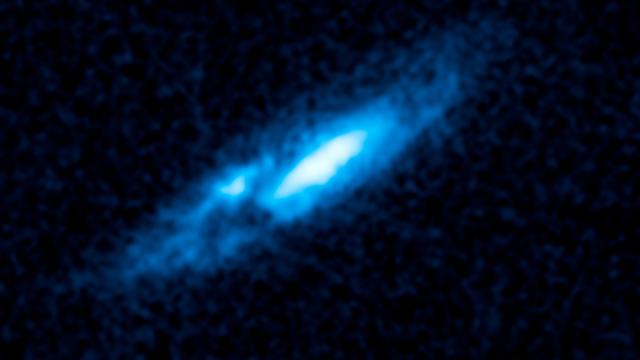Astronomers are calling it the “Nasty 1” but the hefty, rapidly ageing star that shines in the centre of the image above sure is beautiful. It’s also damn peculiar, and it may hold clues to a stellar mystery that’s puzzled scientists for decades.
First discovered over fifty years ago, Nasty 1, whose nickname derives from its catalogue name NaSt1 (oh, astronomy humour), is what scientists call a Wolf-Rayet star. Wolf-Rayets are typically large, rapidly evolving stellar bodies that form by shedding their hydrogen-filled outer layers quickly, exposing a bright hot, helium-burning core. While Wolf-Rayets as a family are fairly common, Nasty 1 is a bit of a head scratcher.
When astronomers imaged the star recently using Hubble, they expected to see twin lobes of gas flowing from opposite sides, similarly to what’s been observed in other Wolf-Rayet candidate stars. Instead, we see a massive disk of gas orbiting the thing. How did a 2 trillion mile wide stardust pancake form around Nasty? Perhaps, by an unseen companion that’s literally devouring the star and spewing its cosmic entrails everywhere in the process.
“We were excited to see this disk-like structure because it may be evidence for a Wolf-Rayet star forming from a binary interaction,” said Jon Mauerhan of UC Berkeley, lead author on the new Nasty 1 paper which appeared this week in Monthly Notices of the Royal Astronomical Society. “There are very few examples in the galaxy of this process in action because this phase is short-lived, perhaps lasting only a hundred thousand years, while the timescale over which a resulting disk is visible could be only ten thousand years or less.”
If Mauerhan is correct, we can definitely count ourselves lucky to be witnessing this — the nebula surrounding Nasty is just a few thousand years old and roughly 3,000 light years from Earth. Had this star been much older, or much further out from our line of sight, we might have missed its evolution entirely.
In their paper, the researchers outline a hypothetical scenario that describes what’s going on. Basically, as Nasty star has evolved, it’s been swelling up. Its outer hydrogen envelop has become looser and more vulnerable to a process known as gravitational stripping. A nearby companion star has begun cannibalising the envelope, growing like a parasite as it devours Nasty, and helping the larger star complete its Wolf-Rayet transformation.

Artist’s illustration reveals a vast disk of gas surrounding a massive, bright Wolf-Rayet star (shown at center). A close companion star is pulling gas from the Wolf-Rayet, shown by the bridge of bright material connecting the two stars. Image credit: NASA, ESA, and G. Bacon (STScI)
The mass-transfer process in binary star systems isn’t always efficient. Some of the stripped matter might spill out during the gravitational tussle between the stars, causing a thick disk of star guts to form.
“That’s what we think is happening in Nasty 1,” Mauerhan said. “We think there is a Wolf-Rayet star buried inside the nebula, and we think the nebula is being created by this mass-transfer process. So this type of sloppy stellar cannibalism actually makes Nasty 1 a rather fitting nickname.”
The processes shaping Nasty 1’s evolution — if the astronomers turn out to be correct — may be more important than we once realised. Another theory suggests that Wolf-Rayets form all by themselves, when powerful stellar winds blow off a star’s outer hydrogen layer. But that hypothesis has been losing steam recently, because direct mass loss alone can’t account for the sheer number of Wolf-Rayets scattered throughout the galaxy. Star-on-star cannibalism, on the other hand, might.
“We’re finding that it is hard to form all the Wolf-Rayet stars we observe by the traditional wind mechanism, because mass loss isn’t as strong as we used to think,” said study co-athor Nathan Smith of the University of Arizona in Tucson. “Mass exchange in binary systems seems to be vital to account for Wolf-Rayet stars and the supernovae they make, and catching binary stars in this short-lived phase will help us understand this process.”
The more we learn about the epic forces at play throughout our galaxy, the more grateful — and surprised — I am that that our little blue marble hasn’t yet been swept up in the cosmic feasting frenzy. [Hubble]
Top image credit: NASA, ESA, and J. Mauerhan
